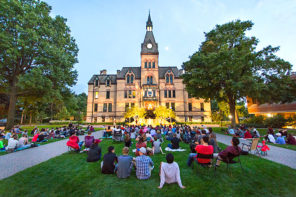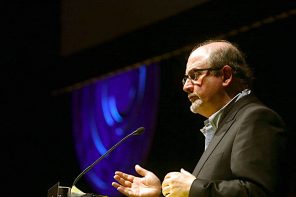Update: Since the initial publication of this blog post several people have written to me to note that CNN did do a short piece on the Aga Khan’s visit, as did some of the cable news channels. Apologies for missing this; however, my basic point remains unchallenged. In a largely positive piece on religion a section is inserted stating that some Muslims don’t consider the Isma’ilis Muslim, putting the discussion in the frame of conflict once more.
Even with Pope Benedict’s visit to the United States last week, I was pleasantly surprised to see some fairly major coverage of the visit of another religious leader, the Aga Khan. He is the head of a Shi’ah community known as the Isma’ilis, who officially have 15-20 million members worldwide. CNN’s 360º Blog ran two pieces: one by Zarifmo Aslamshoyeva and one by Reza Aslan; OnFaith had a piece by Eboo Patel. There was no other national coverage I could find, although local coverage was fairly good, such as this piece from a Houston Chronicle blog.
Aslamshoyeva’s piece focused on the meaning of the Aga Khan as both religious leader and philanthropist (CNN article, AKDN Web site). It was a moving piece on nature of hope and belief. Aslan’s post focuses mostly on the charitable work of the Aga Khan and asks the key question that immediately came to my mind when I started looking for coverage of the Aga Khan’s visit: “Americans are interested in hearing a major Muslim leader speak of tolerance and cooperation, so why isn’t the media covering the Aga Khan’s visit?” Patel, with his interfaith interest, focused on the message of Pluralism the Aga Khan espoused, and the role education plays in generating a sense of pluralism amongst people.
All these messages are accurate and necessary, but of the three writers of this event, all are Shi’ah, and two are Isma’ili, followers of the Aga Khan. Looking at that spread, one would think Shi’ah dominate America’s Muslim population, or at least its intellectual landscape. All of these pieces are blog pieces, not one news report among them. The Sunni community is well aware of the works of the Aga Khan and has a great deal of respect for them. Shahed Amanullah, founder of altmuslim, said in an interview, “There are a lot of non-Isma’ili Muslims around the world who wish they had a leader that is as organized and as visionary.”
One way of explaining this lopsided coverage is to think about how religion is covered in general. Hannah Farber, working off of Terry Mattingly, points out that reporters play a mediating role in explaining internal words to an external audience. Even in the event that a message is crafted to an external audience, a reporter must have some understanding of the religious system in order to make it comprehensible to their readership. As we have witnessed since 9/11, knowledge about Islam and Muslims is painfully lacking even amongst some of the most educated people in our society, and religion is generally not a good return on investment in terms of background learning for journalists. As a result, unless the religion is mired in conflict, it does not get covered, a point raised by Pastor Dan. Conflict is easy to understand and frame, with little nuance necessary.
With respect to Islam, the current dominant narrative is that Shi’ah and Sunni have been in conflict for 1400 years and are always trying to kill each other. As I have argued elsewhere, this view of history is untenable, and reads present day concerns back into the past. Even amongst those whom I believe know better, the rhetoric is normative. For example, Aslan says, “The Isma’ilis are Shi’ah who broke off from the main Shiite branch of Islam.” The fact that there is a larger number of non-Isma’ili Shi’ah does not make them the main branch. If the central belief of Shi’ism is the belief of Imamah, then the only group with a present, living Imam are the Isma’ilis, making them the main group. The point is that there are many ways to claim superiority, but the reality is most Muslims have lived with various other communities of interpretation. The rhetoric of conflict now permeates our discourse on religion. Once religion is framed in conflict, it must always be presented that way. When a man who leads a large Muslim community, is believed to be descended from the Prophet Muhammad, and who derives his authority from that claim, comes to the United States it should be a major news story. Unfortunately, his message of tolerance, peace, pluralism, and education do not fit in the conflict framework. I see people who have much smaller constituencies and less of a legitimate claim to leadership on TV spewing vile rhetoric that gets covered because it fits the frame.
The frame of religion in conflict is one that is not only favored by those who don’t know about the faith, but is also propagated by the extremists within a tradition. The easiest way to draw acolytes to a cause is to convince individuals that they are besieged and need to “circle the wagons.” The Saudi state, hardly the most impoverished people on Earth, uses the foil of Iran, or the Crusader Nation, or the Zionist Aggressor, to bind their people to Wahhabi ideology. The logical outgrowth of the ideology was the Taliban and al-Qaeda. By not understanding and portraying how odious these movements are to many Muslims, they contribute to the recruiting causes of these groups. The weak reporting inserts itself into popular discourse making a hatred of Muslims that didn’t exist before seem more real to Muslims. A cycle is created between reporting on religion as a source of conflict and those who want to make religion a source of conflict.
I marvel at the fact that seven years after 9/11 the US media doesn’t understand how complicit it is in supporting this cycle of violence. A short course on Islam may have been a poor ROI before, but now it seems like a necessity. In England, an avowed atheist, writes almost 2 years after the London subway bombings that Islam is “an uplifting and happy faith.” While I don’t expect US journalists to adopt this fawning attitude, I do wish they would educate themselves to educate us. The Aga Khan’s visit just highlights the structural deficiencies in how we talk about religion.




